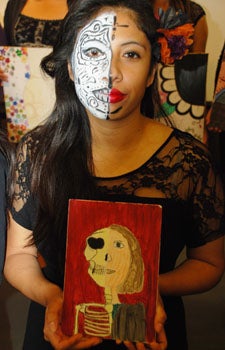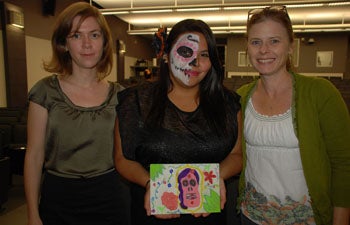‘O, I Die, Horatio’
Foil shimmered under the spotlight as two young actors traded feints, thrusts and parries. As their black boots shuffled furiously, the flecks of foil that made up their swords flew around the stage.
The actors kept going, their emotions raw and real.
“O, I die, Horatio,” said Bryan Garcia, splayed out, clutching his side as he played Hamlet. “The potent poison quite o’ercrows my spirit. I cannot live to hear the news from England. But I do prophesy the election lights on Fortinbras. He has my dying voice . . . The rest is silence.”
“Now cracks a noble heart,” said Nicolas Cortez, playing Horatio. “Good night, sweet prince.”
William Shakespeare’s Hamlet was performed Nov. 1 by seniors from James A. Foshay Learning Center near USC in front of a packed house at Taper Hall on the University Park campus. Their teacher Jacqueline Barrios partnered with Julianne Werlin, a Provost Postdoctoral Fellow at USC Dornsife’s Department of English, to produce the collaboration and showcase HamLab. Barrios directed with Paul David Story, an actor and educator for the USC Neighborhood Academic Initiative (NAI), a program preparing students for higher education. Together, they run the NAI Theater Workshop, which produced the showcase.
The project got off the ground when Werlin met with Susan Harris of USC Dornsife’s Joint Educational Project about how her students could participate in the program. Werlin wanted to add a service-learning component to her introduction to Shakespeare course. But she didn’t want to require her students to go into local schools and teach general reading and writing lessons.
“I wanted to do something directly related to Shakespeare, something ambitious,” Werlin said.

Foshay senior Zulma Martinez holds up a painting she created and displayed as part of HamLab.
Harris connected Werlin with Barrios, whose students are participants in the USC Neighborhood Academic Initiative (NAI), a program preparing students for higher education. Werlin’s undergraduates worked with the Foshay students to develop the play and individual roles, and to memorize lines. Foshay students not acting worked on audio and other backstage duties, or painted elaborate art pieces shown during the final company performance of “To Be or Not to Be.”
Many Foshay students blogged about the experience along the way at HamLab.blogspot.com, a site created for the collaboration by NAI senior Kenia Coyoy.
Werlin said she was impressed with the work of her undergraduates and the NAI students, who came up with their own interpretations for their performances.
“There are so many ambiguities in Shakespeare,” Werlin said. “When you have new readers of Shakespeare as these NAI students were, there are few preconceptions of what Shakespeare is supposed to be, what Hamlet is supposed to mean. They brought a fresh interpretation. Often Hamlet is played as a detached intellectual and abstract character. These students played their parts with passionate intensity.”
She said the students in her course received a three-dimensional experience.
“When you are only reading the text you can miss things,” Werlin said. “It’s easy to let ambiguities pass by or to treat Hamlet as a homework assignment. But when you are actually working with other people and treating Hamlet as a performance, you see the real effects of the words.”
Emily Kuperman, a screenwriting major at the USC School of Cinematic Arts and a history minor at USC Dornsife, said some Foshay students initially panicked, worried Shakespeare would be too hard to grasp.
“That’s the coolest moment, when you can see the light bulb go off as a student is reading Shakespeare,” Kuperman said. “ ‘Ah, I get it. I know what Ophelia’s saying. I totally see where Hamlet’s coming from.’ That’s why I like to volunteer. I want to be part of the light bulb experience.”
Even after the performance, Kuperman is continuing to volunteer at Foshay, tutoring the students and helping them to apply for college. A Shakespeare buff, Kuperman was thrilled for the opportunity to share her passion.
“For most of the kids, this was their first time dipping into Shakespeare,” she said. “What’s a better way to dip into Shakespeare than to put it on its feet and do Hamlet?”
After the program, the Foshay students spoke about what they learned from the Hamlet experience.
“I valued all the artists in general. Everything was so amazing,” said Deisy Blanco, trying to suppress tears. “I’m so proud of everybody.”
Manuel Valdez said acting was a great way to vent.
“Normally you can’t get up and scream at the top of your lungs,” he said. “But on the stage, you can.”
Paul Espinoza said acting out the parts gave him a deeper appreciation of Shakespeare.
“You’re not stuck in a classroom reading a book,” he said.
“You don’t actually realize all of the layers to the story until you act them out,” echoed Kenia Coyoy.
Christian Pablo said he found his niche.
“I learned that Hamlet is a very emotional man,” he said. “He was screaming at the top of his lungs and he used a sword. I always wanted to do that. I might want to get into acting. I don’t play sports. But when I started this project, I actually for the first time felt that I belonged to a group. These were people I could connect with.”
Omar Gante praised his teacher.

Julianne Werlin, a Provost Postdoctoral Fellow at USC Dornsife’s Department of English (left), Foshay senior Shannon Cisneros and Susan Harris of USC Dornsife’s Joint Educational Project at HamLab.
“I learned that Ms. Barrios, you’re actually a really great teacher.”
Barrios said she is trying to build similar partnerships with faculty members at USC. As a result of this one, her students learned about more than Shakespeare.
“My students saw the USC students as mentors, but also peers,” Barrios said. “Working with USC students, they could see themselves as college-bound.”
Barrios said acting out Shakespeare gave her students a deep sense of the text and an opportunity to collaborate.
“The text came to life for them,” Barrios said. “They have created a community around this text. A community of readers. At this point in their educational experience, they’ve learned the importance of community.”